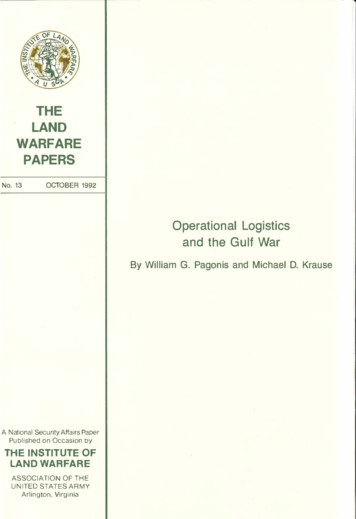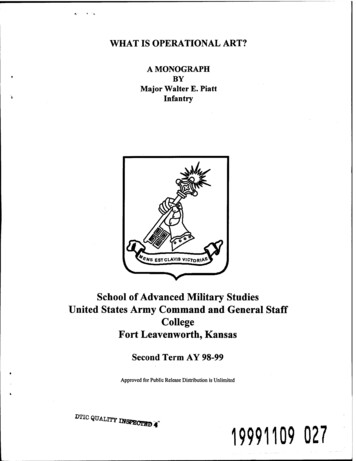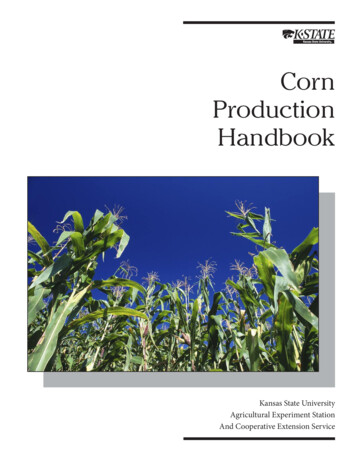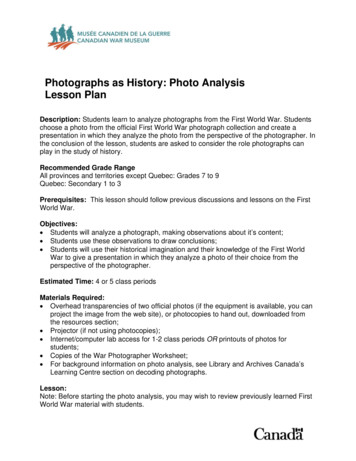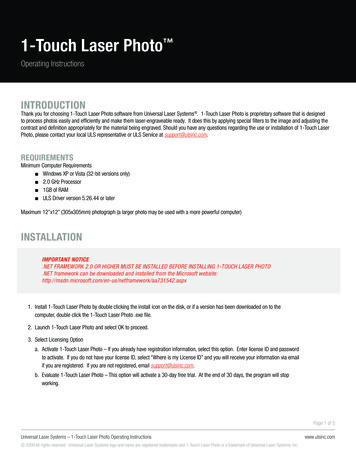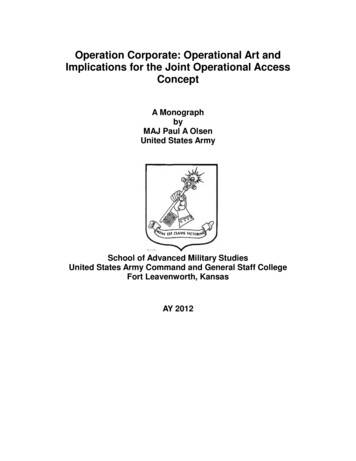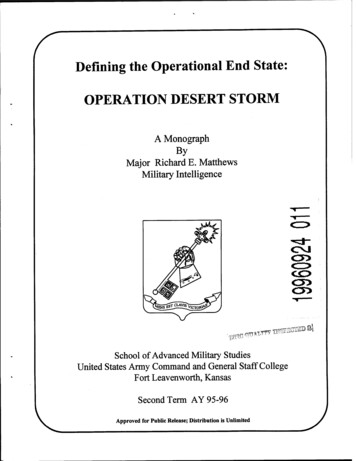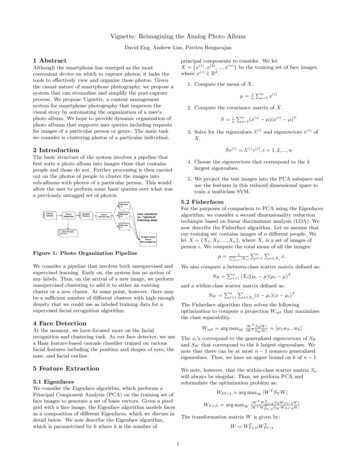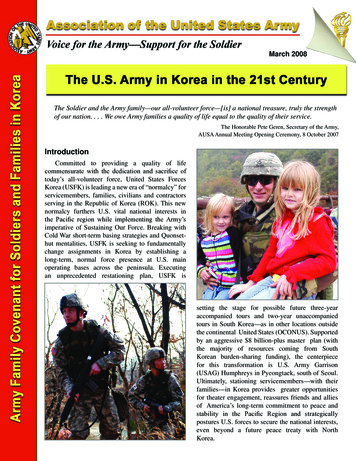
Transcription
March 2008The Soldier and the Army family—our all-volunteer force—[is] a national treasure, truly the strengthof our nation. . . . We owe Army families a quality of life equal to the quality of their service.The Honorable Pete Geren, Secretary of the Army,AUSA Annual Meeting Opening Ceremony, 8 October 2007IntroductionCommitted to providing a quality of lifecommensurate with the dedication and sacrifice oftoday’s all-volunteer force, United States ForcesKorea (USFK) is leading a new era of “normalcy” forservicemembers, families, civilians and contractorsserving in the Republic of Korea (ROK). This newnormalcy furthers U.S. vital national interests inthe Pacific region while implementing the Army’simperative of Sustaining Our Force. Breaking withCold War short-term basing strategies and Quonsethut mentalities, USFK is seeking to fundamentallychange assignments in Korea by establishing along-term, normal force presence at U.S. mainoperating bases across the peninsula. Executingan unprecedented restationing plan, USFK isOperational photoof a 2ID Soldier(or Soldiers)Operational photoof a 2ID Soldier(or Soldiers)setting the stage for possible future three-yearaccompanied tours and two-year unaccompaniedtours in South Korea—as in other locations outsidethe continental United States (OCONUS). Supportedby an aggressive 8 billion-plus master plan (withthe majority of resources coming from SouthKorean burden-sharing funding), the centerpiecefor this transformation is U.S. Army Garrison(USAG) Humphreys in Pyeongtaek, south of Seoul.Ultimately, stationing servicemembers—with theirfamilies—in Korea provides greater opportunitiesfor theater engagement, reassures friends and alliesof America’s long-term commitment to peace andstability in the Pacific Region and strategicallypostures U.S. forces to secure the national interests,even beyond a future peace treaty with NorthKorea.more . . .
While American military presence on the Asianmainland began at the end of World War II andcontinued primarily because of the Korean War,today’s strategic rationale for forward-deployed,family-accompanied tours in Korea extends farbeyond the peninsula. With nearly one fourth of U.S.and a quarter of the world’s trade flowing throughNortheast Asia, a normal U.S. force presence in Koreawill help secure sustained market and resource access,ensure peace and stability, and nurture relationshipswith likeminded friends and allies in a region filledwith extraordinary opportunities and enormouschallenges. Having lost its patron states at the end ofthe Cold War, North Korea has a degraded ability towage major conventional war, but remains a primarythreat to regional and global security through itsasymmetric weapons of mass destruction programsand proliferation. Northeast Asia also has numerousflashpoints for instability with: 2five of the six largest militaries (including Chinaand Russia); four proven nuclear powers (China, Russia, NorthKorea and the United States); heightened nationalism; and competition for natural resources amongst regionalpowers, including the opening opportunities alongthe Northwest Passage due to the realities of globalclimate change.With nearly 29,000 servicemembers (including20,000 of the 280,000 forward-deployed U.S. Soldiersaround the world), USFK represents less than 2percent of America’s active military force—a smallcommitment for such significant strategic gains.Transforming the Army’s StrategicApproach to KoreaFor more than 50 years, Korea was America’sstanding war. “Hardship duty on ‘Freedom’sFrontier’” described the mindset of repeated oneyear unaccompanied tours in austere locations.www.ausa.org
Correspondingly, the Army had a short-term approachto managing its installations and quality-of-life issues.In fact, some servicemembers still live and workin structures labeled “temporary” since the 1950s.Today, to support American strategic interests and theSustain Our Force imperative in Asia, the U.S. Armyis transforming its overall approach to stationing andinstallation management on the Korean Peninsula.Given the long-term strategic importance of Northeast Asia, the U.S.-ROK alliance (one of seven U.S.mutual defense treaties, or MDTs)1 is a cornerstone ofAmerica’s global security framework. As an industrialpower and stalwart ally (having militarily supportedU.S. efforts in Vietnam, the first Gulf War, Somalia,Iraq and Afghanistan and United Nations missionsin East Timor and Lebanon), the Republic of Koreais positioning itself to assume wartime control of itsforces in 2012, with the United States shifting to adoctrinally supporting role. In conjunction with U.S.and ROK government bilateral agreements to relocateU.S. forces out of Seoul and the 2d Infantry Division(2ID) south of Seoul, this transformation presentsthe Army with an unique opportunity to change itsapproach to garrison master planning and, ultimately,the design of quality-of-life facilities available onits enduring installations. This planned realignment1provides unprecedented opportunities for the Armyand Installation Management Command (IMCOM)to improve quality of life for servicemembers andfamilies by developing Army-standard, moderninstallations and eliminating the temporary infrastructure dating back to the mid-1950s.Partnerships for a New NormalcyUSFK and Eighth U.S. Army are in the midstof the largest and most complex transformation andrealignment process in the Department of the Armyand arguably within the Department of Defense.Simultaneously, the commands are evolving thecommand and control relationship with the ROKmilitary, transforming Eighth U.S. Army from anArmy service component command to a warfightingcapable Operational Command Post-Korea in June2008 and realigning the footprint of U.S. forceson the peninsula. Building and transforming therequired supporting infrastructure to reposition thecommand’s installation footprint and to sustain amore robust population requires concerted energy andsynchronized support from numerous commands andagencies. USFK is working closely with the services(particularly the Army as the executive agent forinstallations through IMCOM), IMCOM-Korea, U.S.Army Corps of Engineers-Far East District, and the1949 North Atlantic Treaty Organization; 1951 U.S.-Philippines MDT; 1952 ANZUS MDT; 1954 U.S.-Japan MDT; 1954 Southeast Asia CollectiveDefense Treaty; 1954 ROK-U.S. MDT; 1954 U.S.-United Kingdom MDT.www.ausa.org3
U.S. Army Medical Command. Also important areDoD activities such as the Department of DefenseEducation Activity (DoDEA) and Department ofDefense Dependents Schools (DoDDS), the DefenseCommissary Agency (DeCA), the Army & AirForce Exchange Service (AAFES), and the UnitedService Organizations (USO) and Red Cross. Withinternational agreements directing the realignmentand substantial host nation burden-sharing monies,the Republic of Korea itself is a major partner.as well as a thriving democracy, having conducted itsfifth free and fair presidential election in December2007. This economic and political growth, coupledwith political and social recognition in hosting the 1988Olympics, the 2002 Soccer World Cup and the future2012 World Expo, has translated into a national priorityto enhance the living standard and quality of life forthe 50 million Korean citizens and more than 700,000foreign nationals, including U.S. servicemembers andfamilies, living in South Korea today.Republic of Korea Today. With an impressive arrayof western-style shopping malls and movie theaters,sports complexes, museums, temples and palaces,world-class hospitals, pioneering research centers anduniversities, combined with centuries-old customs andtraditions, South Korea offers a standard of living andquality of life commensurate with that found in Japan,Europe and the United States. Efficient transportationsystems and interstate highway networks connectmetropolitan areas. As the 11th largest economy in theworld, South Korea is an established economic power,Keeping Families Together in the Republic of Korea.Coinciding with the signing of the Army FamilyCovenant in October 2007,2 the USFK commanderincreased command sponsorship family opportunitiesfrom approximately 10 percent of the force to about20 percent, initiating a measurable change towardnormalcy. By reducing unaccompanied one-year familyseparations, which have been the norm in Korea for 55years, USFK offers family stability between combattours—a key means to Sustaining Our Force giventoday’s current personnel tempo (PERSTEMPO) a.org
In the immediate future, 5,653 USFK servicemembersmay bring their command-sponsored families for astabilized two-year tour; many will have the optionto extend for an additional year with the KoreaAssignment Incentive Program.Although the vast majority of servicememberscurrently serve unaccompanied tours in Korea, agreat many choose to bring their families without thebenefit of command sponsorship. Increasing in partbecause of the high PERSTEMPO for Operations IraqiFreedom and Enduring Freedom, this trend presents akey challenge, but one the command continues to meet:affording all eligible personnel access to the Armystandard, comprehensive services they deserve—fromfamily housing to Army Community Services (ACS),Morale, Welfare and Recreation (MWR), AAFES, andDeCA support such as regularly stocked family-careitems. While USFK phases in additional commandsponsored families, the command is working manyinitiatives in fulfilling the Army Family Covenantpledge to enhance support for families of the allvolunteer force.Installation Management Command Korea. Giventhe long-term importance of providing normalcy toU.S. servicemembers and families, IMCOM-K is thebackbone of USFK’s ability to fulfill the Army FamilyCovenant. In addition to its core responsibilities ofproviding base operations support and services acrossfour primary garrison commands geographicallydispersed across South Korea, IMCOM-K is in theunique position of leading USFK’s theater-wide masterplanning effort. Backed by programmed resourcesfrom both the ROK and the United States, IMCOM-Kis capitalizing on this opportunity to get it right, fromthe bottom up.Installation ManagementCommand - KoreaArea IU.S. Army GarrisonRed CloudArea IIU.S. Army GarrisonYongsanU.S. Army GarrisonHumphreysArea IIIU.S. Army GarrisonDaeguArea IVSource: U.S. Forces KoreaOver the next five years, as USFK and 2ID relocatesouth to USAG-Humphreys, this former single-Soldiercamp with fewer than 9,500 personnel will grow to aninstallation of more than 200 separate organizationsand a population of 44,300—a 470 percent increase.Guided by a comprehensive installation design guide,IMCOM-K is designing and executing a theatermaster plan that will deliver more than 600 new andrenovated facilities, while growing its real propertyinventory from 4.5 million square feet to over 29million square feet—the approximate size of FortBragg, North Carolina. Additionally, IMCOM-K isimplementing successful, state-of-the-art antiterrorismand force protection initiatives. The success of theseefforts is underscored by the fact that in 2007, USAGHumphreys took the top two honors in the Army-wideantiterrorism awards program.www.ausa.org5
anticipated increased numbers of command-sponsoredfamilies there. Initiatives such as this help to ease theburdens faced by non-command-sponsored familiesand are an incremental means to bridge the gap as thecommand moves towards normalcy.Already furnished with a new family waterpark and modern family housing and recreationcenters, USAG-Humphreys will also build a newpost exchange shopping complex, a 26 millionfood, beverage and entertainment center and a newcommissary. The Humphreys master plan uniquelysupports USFK’s normalcy initiative by deliveringentire family communities that will include threeembedded elementary schools, one middle schooland one high school—all within walking distance,eliminating the need for on-post busing. ExistingMWR facilities include one of the largest familyfitness centers anywhere in the Army, two large multisports complexes, Laser Tag, RC Track racing, thepeninsula’s largest paint-ball range and a future 18hole golf course.While master-planning new facilities and services,IMCOM-K is simultaneously renovating and sustainingestablished facilities and services at 55 other activeArmy camps, ranges and remote sites, including thosein Area I north of Seoul where more than 1,000 noncommand-sponsored family members live withoutofficial support. However, IMCOM-K supports andstaffs one-of-a-kind family-focused cottages thatdeliver social support services to all families. Withamenities such as Internet service, washers and dryers,full kitchens and play areas for children, as well asservices such as Army Family Team Building classes,family members have the opportunity to develop amutual support network and build bonds, knowing thatthe Army cares for them. AAFES also now sends out aweekly “rolling PX” stocked with children’s clothingand care products. Twelve miles south of Seoul,IMCOM-K continues to work with DeCA to establisha commissary at K-16 Air Base to better serve the6USFK and DoDDS-Korea: Partners in Education.With approximately 4,000 school-aged familymembers attending the eight DoDDS-Korea schools,USFK and DoDDS-K formed a unique partnership in2006 to improve the overall quality of the educationalexperience in Korea. Coordinating and integrating theefforts and responsibilities of various stakeholders,including the IMCOM-K garrison commands andsupporting youth services, this formal partnershipdevelops annual action plans endorsed and promulgated by the USFK commander.Improved Internet-based resources for incomingfamilies have eased the transition and bridged thegaps of time and distance from CONUS-basedlocations. Often, the biggest challenge facing familiesis a lack of timely information allowing them to makeinformed choices. The DoDDS-K website, www.korea.pac.dodea.edu, is a valuable tool for all familiesaccompanying their servicemembers to Korea. Thisonline assistance will prove essential in 2008 as thenumber of command-sponsored families increases. InSeoul, the USAG-Yongsan schools will gain up to 350additional students for the 2008–2009 school year, a16 percent increase. USAG-Humphreys and USAG-www.ausa.org
around Seoul have improved facilities for athleticand community activities year round, with more tobe completed in 2008 at USAG Daegu. With theArmy Family Covenant signing in Korea, IMCOM-Khas further pledged to develop and improve familyprograms across the command.Daegu will also increase their enrollments accordingto their infrastructure capabilities and the regulatoryguidance for teacher-student ratios.To date, DoDDS-K has been able to accommodateall eligible children, including wait-listed, noncommand-sponsored children enrolled on a spaceavailable basis. Individual permanent change of station(PCS) orders for the Army and the other services nowrequire all servicemembers bringing school-agedchildren to Korea to preregister on the DoDDS-Kwebsite, directly linked from the USFK homepage,www.usfk.mil. This website also remedies one of thegreatest challenges facing DoDDS-K: the visibility ofinbound students prior to the first day of school.Medical Care and Families. With the Acting SurgeonGeneral of the Army present on 2 November 2007,the Army activated a Medical Department Activity(MEDDAC), a Dental Activity (DENTAC) and aDistrict Veterinary Command (DVC) in the Republicof Korea. This was another milestone in improving theoverall quality of life and establishing normalcy forservicemembers and their families. The commands havethe authority to lay out their requirements, directly hiremultidisciplinary medical professionals, and thus buildand grow a capability that provides more precise carefor servicemembers, spouses, children and civilians.Offering comprehensive medical care is a measurablestep towards providing normalcy and an enhancedquality of life.The establishment of MEDDAC and DENTACcommands coupled with the overall increase incommand-sponsored positions will allow the TRICAREOverseas Program (TOP) to provide comprehensivehealth care for more USFK servicemembers andfamilies. Unique to Korea, a regional TRICAREmanager assists with paperwork, coordinates referralsand provides transportation to selected host-nationmedical facilities, each of which has English-speakingdoctors and staff (many trained in the United States),to ensure high-quality communication and medicalservice. This is just another step toward providing aquality of life proportionate to the level of commitmentdemonstrated by the all-volunteer force.Aware that students living in Korea do not havethe same “outside the gate” opportunities as studentsat CONUS-based installations, the USFK–DoDDS-Kpartnership actively seeks and promotes extracurricularvenues for school-aged children. From activities andclubs, a variety of sports teams and summer school,students have a range of extracurricular activities, manylinked to local Korean student clubs and activities.IMCOM-K also supports a robust summer youthemployment program for full-time students, providingwork experience for servicemembers’ children whilein the Republic of Korea. With new 750,000 artificialsports fields at the Seoul American High School andCamp Casey, servicemembers and families in andwww.ausa.org7
Republic of Korea-U.S. Alliance2012 and BeyondStrategic Rationale Enduring alliance and partnership Secure global economic/security interests Promotion of regional stability Strategic hedge against future uncertaintySeoulOsan Air BaseGarrison HumphreysTransformation Endstate Operational control transfer completed April 2012*Korea Command (KORCOM) Joint Warfighting Headquarters*Operational Command Post-Korea (OCP-K) Eighth U.S. Army Warfighting HeadquartersCamp Mujuk (USMC)Garrison DaeguKunsan Air BaseChinhae Naval Base Seventh Air Force (7AF) Marine Forces Korea (MARFOR-K) Naval Forces Korea (NAVFOR-K) U.S. forces relocated south of SeoulTour Normalcy Endstate Transition to three-year family-accompanied tours Transition to two-year unaccompanied tours Parallel Europe/Japan overseas tour policiesSource: U.S. Forces KoreaThe Way AheadThe Army’s long-term ability to provide trainedand ready Soldiers to defend U.S. interests aroundthe world is dependent upon retaining the allvolunteer force through solid support systems anda high quality of life—which plays a vital role inrecruitment and retention for both servicemembersand the civilian workforce. Theater transformationinitiatives and normalized assignments in Korea canbe another important element of the Army’s abilityto Sustain Our Force, especially in considerationof record PERSTEMPO. Reprogramming and newprogramming in military personnel and constructionappropriations are necessary. However, the impacton funding and personnel will be minimal and8consistent with U.S. forces based in Japan andEurope, especially with Korea’s substantial annualburden-sharing monetary assistance. The end-statewill reduce overall PCS costs and the need forentitlements resulting from family separation.Establishing a normal, long-term joint forcepresence on the Korean Peninsula sends a powerfulsignal to both U.S. allies and potential adversariesalike of America’s unwavering commitment todemocracy, free trade and stability in Northeast Asia.The end result will be a strengthened alliance withthe Republic of Korea, an enduring presence on theAsian mainland and a new normalcy for all U.S.servicemembers, families and civilians.www.ausa.org
Cold War short-term basing strategies and Quonset-hut mentalities, USFK is seeking to fundamentally change assignments in Korea by establishing a long-term, normal force presence at U.S. main . park and modern family housing and recreation centers, USAG-Humphreys will also build a new . post exchange shopping complex, a 26 million .
